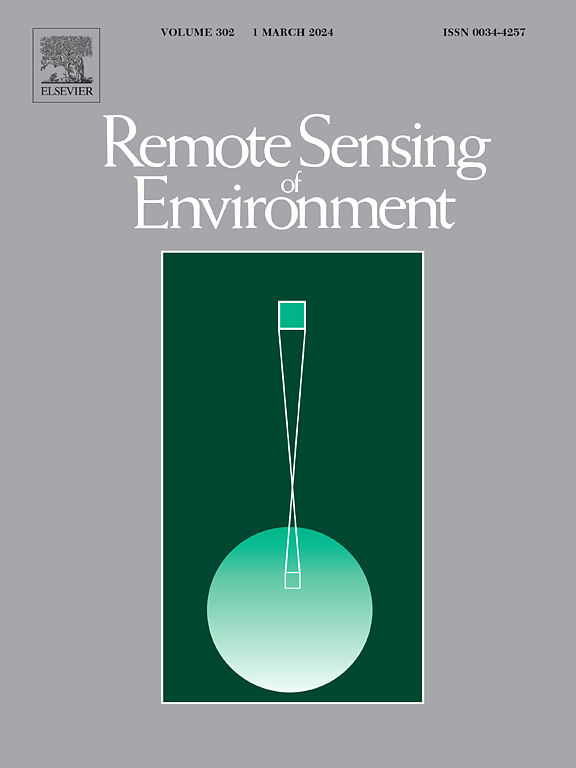Global retrieval of canopy chlorophyll content from Sentinel-3 OLCI TOA data using a two-step upscaling method integrating physical and machine learning models
IF 11.1
1区 地球科学
Q1 ENVIRONMENTAL SCIENCES
引用次数: 0
Abstract
Canopy chlorophyll content per ground area (CCC, g·m−2) is tightly related to vegetation photosynthesis and is a promising indicator of photosynthetic capacity. However, a global operational CCC product is not yet available. To fill this gap, we developed a two-step upscaling method to estimate global CCC from Sentinel-3 OLCI top-of-atmosphere (TOA) reflectance. In the first step, a physically-based PROSAIL-D inversion model produced accurate CCC maps from over 20,000 high-spatial resolution (1 m) airborne hyperspectral images collected across 50 sites within the National Ecological Observatory Network (NEON) between 2019 and 2021. The validation against ground CCC measurements showed an R2 of 0.89 and an RMSE of 0.30 g·m−2. In the second step, these high-resolution CCC maps were resampled or upscaled to a spatial resolution of 300 m, and combined with Sentinel-3 OLCI TOA reflectance images to train random forest (RF) models. The RF model demonstrated robust performance with leave-one-site-out cross-validation, yielding an R2 of 0.92 and RMSE of 0.14 g·m−2. The two-step method also showed minimal sensitivity to angular effects and land cover variations, underscoring its robustness. In comparison, the traditional direct inversion method (the one-step method) led to underestimation of CCC by 0.16 g·m−2 and a moderate estimation accuracy (R2 = 0.65, RMSE = 0.30 g·m−2). We generated a long-term global OLCI CCC product using Sentinel-3 OLCI TOA reflectance data from 2016 to 2024, which can also be continuously updated using current data. This global CCC product can provide important plant physiological information, for parameterizing terrestrial biosphere models and capturing spatiotemporal photosynthetic patterns, thereby advancing research on vegetation carbon dynamics cycles at the global scale.
基于物理模型和机器学习模型的Sentinel-3 OLCI TOA数据的冠层叶绿素含量全局反演
每地面面积冠层叶绿素含量(CCC, g·m−2)与植被光合作用密切相关,是反映植被光合能力的重要指标。但是,目前还没有一个全球性的可操作的CCC产品。为了填补这一空白,我们开发了一种两步升级方法,从Sentinel-3 OLCI大气顶(TOA)反射率估计全球CCC。在第一步中,基于物理的PROSAIL-D反演模型从2019年至2021年期间在国家生态观测站网络(NEON)的50个站点收集的20,000多张高空间分辨率(1米)机载高光谱图像中生成了精确的CCC地图。对地面CCC测量值的验证表明,R2为0.89,RMSE为0.30 g·m−2。在第二步中,这些高分辨率的CCC地图被重新采样或升级到300 m的空间分辨率,并与Sentinel-3 OLCI TOA反射图像相结合,以训练随机森林(RF)模型。RF模型经留一位点交叉验证显示出稳健的性能,R2为0.92,RMSE为0.14 g·m−2。两步法对角度效应和土地覆盖变化的敏感性最小,强调了其鲁棒性。相比之下,传统的直接反演方法(一步法)导致CCC低估0.16 g·m−2,估计精度适中(R2 = 0.65, RMSE = 0.30 g·m−2)。我们使用2016 - 2024年Sentinel-3 OLCI TOA反射率数据生成了一个长期的全球OLCI CCC产品,该产品也可以使用当前数据持续更新。该全球CCC产品可提供重要的植物生理信息,用于参数化陆地生物圈模型和捕获光合作用时空模式,从而推进全球尺度上植被碳动态循环的研究。
本文章由计算机程序翻译,如有差异,请以英文原文为准。
求助全文
约1分钟内获得全文
求助全文
来源期刊

Remote Sensing of Environment
环境科学-成像科学与照相技术
CiteScore
25.10
自引率
8.90%
发文量
455
审稿时长
53 days
期刊介绍:
Remote Sensing of Environment (RSE) serves the Earth observation community by disseminating results on the theory, science, applications, and technology that contribute to advancing the field of remote sensing. With a thoroughly interdisciplinary approach, RSE encompasses terrestrial, oceanic, and atmospheric sensing.
The journal emphasizes biophysical and quantitative approaches to remote sensing at local to global scales, covering a diverse range of applications and techniques.
RSE serves as a vital platform for the exchange of knowledge and advancements in the dynamic field of remote sensing.
 求助内容:
求助内容: 应助结果提醒方式:
应助结果提醒方式:


